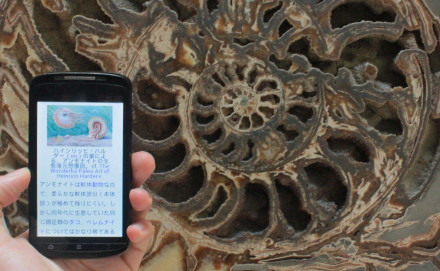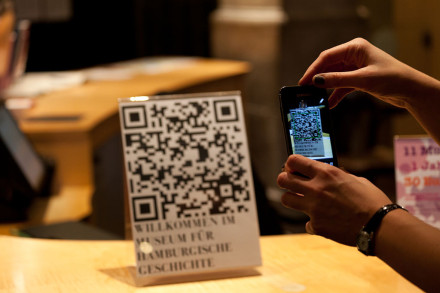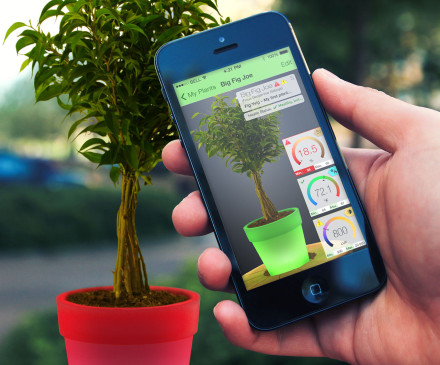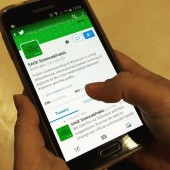The advanced connectivity and computing power of Smartphones opens up new possibilities for science communication, and an increasing number of institutions are experimenting with this great potential. That’s the topic of the thesis I published as part of my Masters of Science Communication, in which I look at the potential benefits and limitations of science-related mobile applications. This excerpt summarises the main ideas, and I hope it can be beneficial to some out there.

Use of a mobile app at the Natural History Museum, London. Attribution-ShareAlike 3.0 Unported License
Great potential yet to be explored
For science communication professionals who are continuously exploring new strategies for communicating with current and potential audiences, mobile applications open up the possibility for reaching new audiences through a personal device they have chosen and are familiar with. In the case of science museums and science centres, mobile apps also enable the institutions to reach those audiences not only during the museum visit, but before and after also.
“This ability to reach users in conditions and in an environment of their choice opens up new possibilities for the communication of cultural content for life-long learning and edutainment, in addition to the potential for cultural marketing. Additionally, the fact that these users are connected in a wide network offers possibilities not only for one-to-one communication between the cultural organization and the user, but also for social networking and creating communities of users interested in cultural content, incorporating Web 2.0 capabilities.”
(Economou and Meintani, 2011)
Furthermore, in the past few decades we have been observing a paradigm shift in museum learning which is based on an explorative hands-on approach and focuses on the users’ needs rather than the curators’ key message. While traditional museums put visitors into a passive and ‘guest’ position, this new paradigm is about participation and interactivity and puts the users into an active role (Kahr-Højland in Katz, LaBar and Lynch, 2011).

Use of QR codes in Museum. Image in Public Domain
With their advanced computing abilities and connectivity, smartphones are regarded as the key vehicle for customizing and enhancing visitor experience and seem to fit perfectly into this new learning paradigm. However, in reality, museum mobile applications are not as numerous as we may think, and the few that exist do not seem to significantly enhance the museum visit experience (Valtysson, and Ling in Holdgaard Katz, LaBar and Lynch, 2011). The majority of museums apps developed so far have the form of enriched audio-guided tours (with images, video, and sometimes additional texts), and few of them actually support social interaction and participation.
Facilitate accessibility, encourage dialogue
But edutainment mobile applications are not limited to museums, and science-related apps actually abound. A quick search on iTunes with the keyword “science” gives more than 2,000 results. In my thesis I look at a sample of mobile applications created by science museums, science centres, and research institutes, and analyse the means they used to convey science-related content.

A mobile app for plant care. Creative Commons Attribution-Share Alike 4.0 International License.
It appears that a good way to embrace this new learning paradigm, and retract from the passive one-way information delivery from institution to user, is to enable the user to contribute to the content (e.g. upload photos), ask questions, provide feedback, and share on social networks. Smartphones are connected devices, so let’s use that feature!
To convey science-related content to a large and diverse audience through a mobile app, there are a few things to keep in mind, such as: don’t forget to offer different levels of reading (e.g. with “in-depth” or “further info” options available), make the content available on different platforms (e.g. develop the app on different OS, upload content on website as well), use a level of language adapted to the audience (avoid jargon and keep technical language to a minimum, in a manner that it is not misleading, but that your audience can understand quickly and easily), increase usability (e.g. provide captions for videos, title the back arrows with the previous page’s name, have an option to change contrast and text size), and it’s a smartphone app so use the smartphones features (e.g. camera, microphone, GPS, connectivity, gyroscope…).
A mobile app is the device, not the message
Smartphones do offer a broad range of possibilities to science communicators and can be fantastic devices to communicate science to different audiences, and some apps are truly brilliant. However a mobile app may not be the most adapted tool for everyone’s communication.





